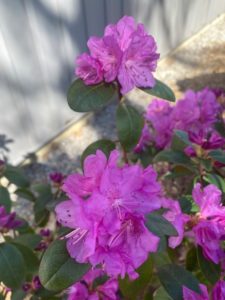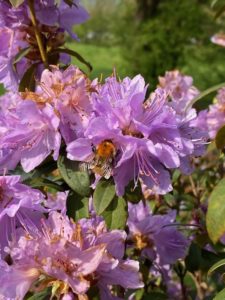For 26 years, Ed lived and gardened in the Annapolis Valley area of Atlantic Canada. Four years ago he relocated (along with 1200 rhodo plants!) to the Brighton area, a far different climate with new challenges.
Ed promotes rhododendrons for their stellar qualities. They bloom in shade, come in a huge range of colours, sizes and bloom characteristics. They can thrive in nutrient poor soil. Their shallow roots mean they transplant easily in early spring. And they’re also hardier than we expect them to be.
Rhododendrons and azaleas are part of the Ericaceae family. Over one thousand divergent species, both evergreen and deciduous, with an impressive range of colours and flower forms, grow worldwide. They are divided into four main groups: azaleas, elepidotes, lepidotes, and vireyas. Rhododendrons hybridize easily within the same group, but less easily between groups, where they are often sterile and can only be propagated vegetatively. Rhododendrons from nurseries are hybrids.
Ed’s focus for decades has been on selecting rhododendrons for large and beautiful blooms, for erect stems that hold the blooms well above the foliage and primarily for a later bloom period. He is cross-breeding rhododendrons to flowers as late as August or September.
Ed’s advice to grow rhododendrons successfully – it’s all about the soil ph. He suggests:
– maintain soil acidity between 4.5 and 6 ph
-use only fertilizer intended for acid loving plants
-use pine or cedar bark, or oak leaves for mulch
-plant in raised beds with a 50/50 mix of peat moss and bark
-don’t bother mixing peat moss into the soil; it won’t change the ph.
-avoid pruning in the spring as buds will be lost
Ed stressed it is very difficult to change sandy loam to a lower ph. However chemicals can be added such as sulpher, ferrous sulphate or chelated micronutrients. Aluminum sulphate is toxic to rhodos.


